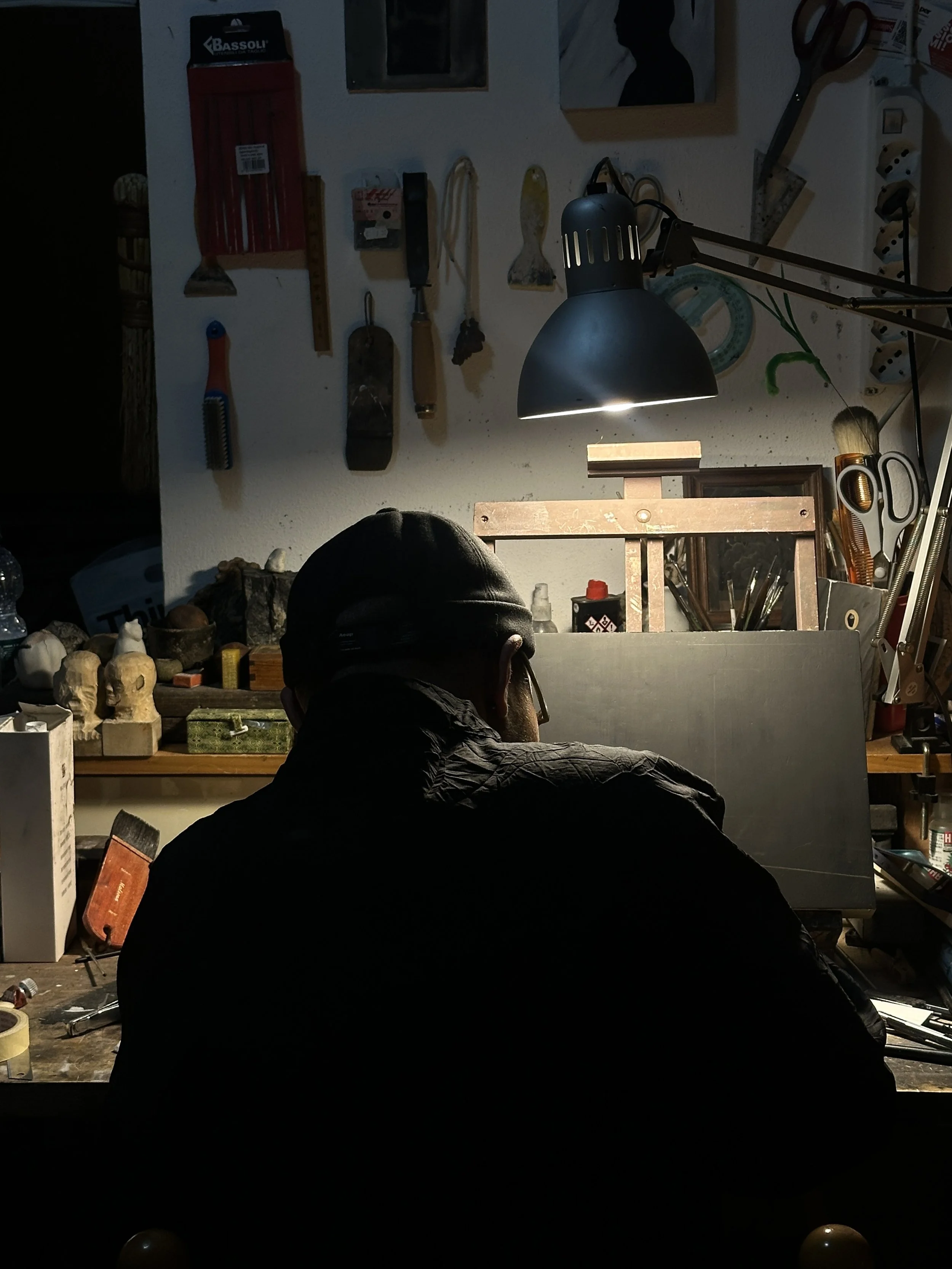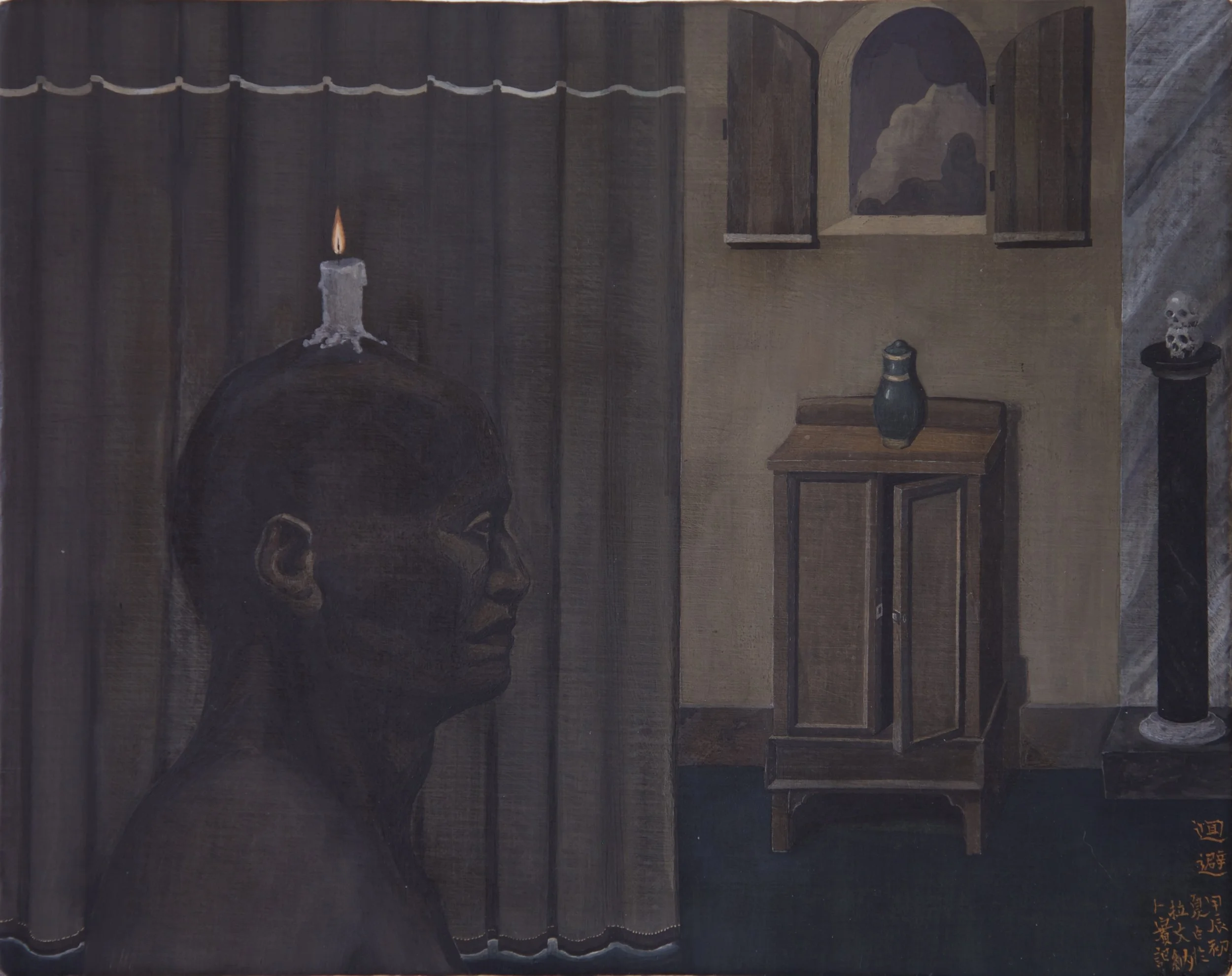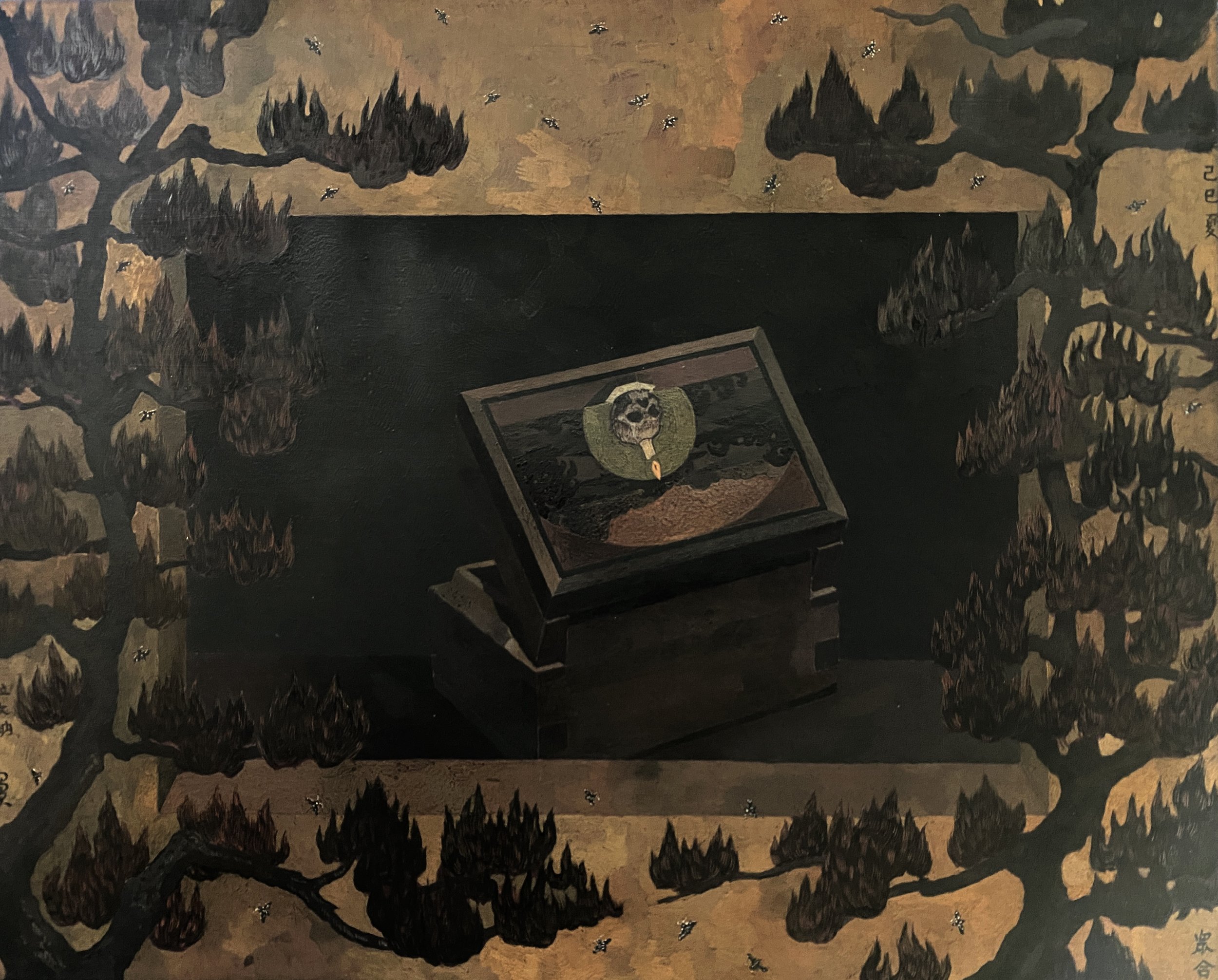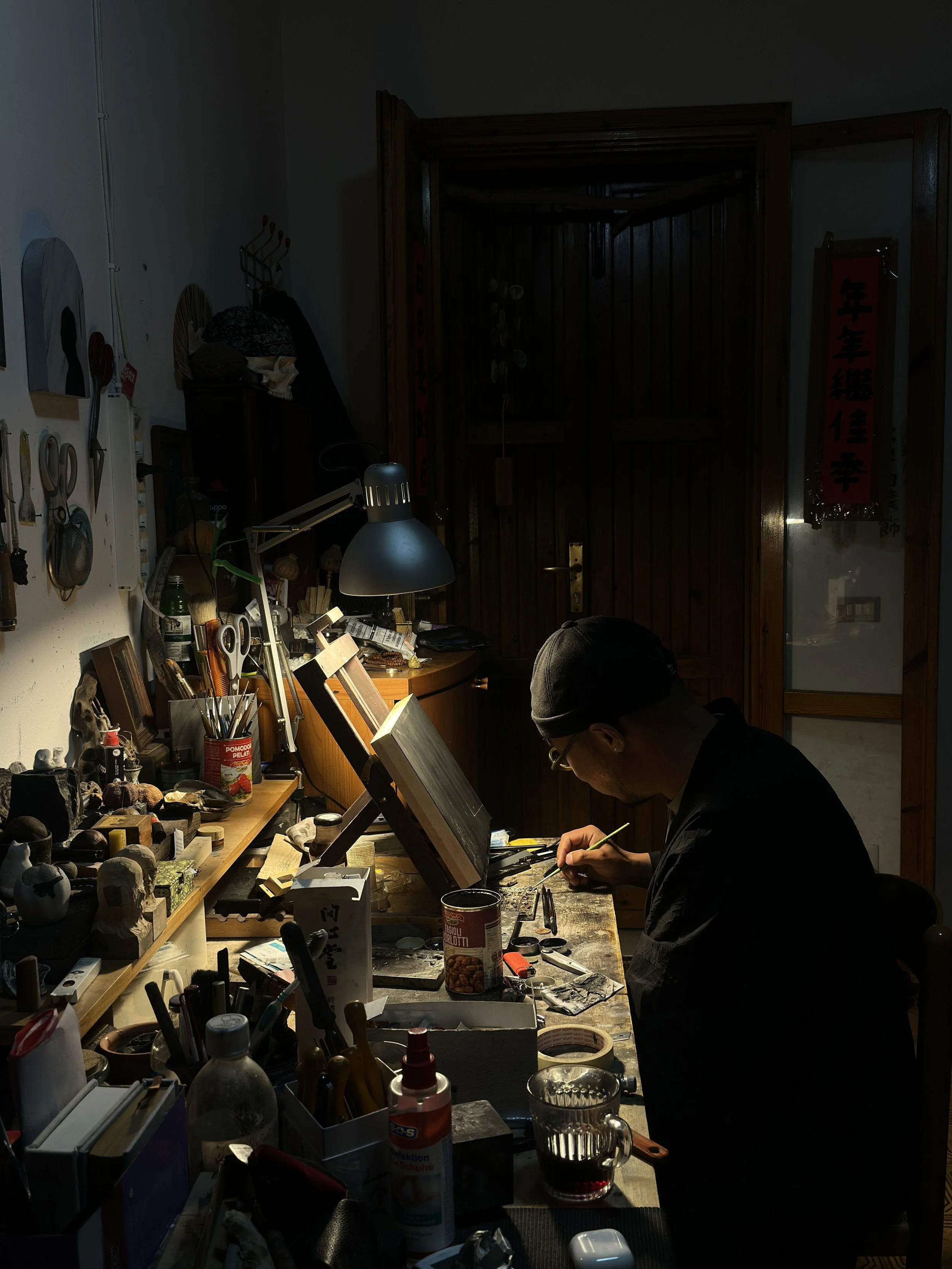Bu Shi in conversation with SARAHCROWN
Meet Bu Shi, artist and master of the dark, shadows, and
Bu Shi in the studio
1. Your paintings often explore the boundary between light and darkness—not just visually, but metaphorically. What draws you to this space of ambiguity, and what does “darkness” mean to you in your work?
Entering this space of ambiguity is the result of my work, not something I consciously sought out from the beginning. If there was an intention at all, it would only be a long-standing desire for self-awareness. As for what this result truly is, I currently understand it as a mysterious field that I have encountered during the process of cultivating such awareness.
The ambiguity lies in the realization that the material and metaphysical worlds cannot be separated and treated independently. This is an ongoing process of moving away from dualism towards a more integrated, holistic unity. As for the “darkness” within this process—at first, I interpreted it through the lens of yūgen in Japanese aesthetics, a kind of aesthetic experience. But now, I’ve come to understand it also as my earliest memory of safety and intimacy, while simultaneously being the part of myself I failed to see—the excuse I used to hide from the shame of desire.
Avoiding, 2024, oil on linen on wood panel, 19.5 x 24.5 cm
2. You merge Eastern aesthetics with references to Western art history. Can you share how these two visual traditions interact or conflict in your creative process?
There is almost no conflict between the two traditions. If there were any, it would stem from inner contradictions within myself—but there aren’t.
I grew up in a time where Eastern and Western sensibilities coexisted. Rather than focusing on cultural identity, I am more drawn to the shared insights they offer when taken together.
Aesthetic distinctions are often rooted in bias, and in this regard, I’ve come to see bias itself as a quality of beauty. Cultural identity, too, must be constructed atop a foundation of bias. As I gradually strip away these biases and look into the inner workings of beauty, the distinctions between East and West begin to dissolve—becoming ambiguous, fluid, and interwoven.
Bu Shi in the studio
Bu Shi, Deep dream, 2025, Tempera on wooden panel, 22 x 27 cm INQUIRE
3. Your works often include self-portraits or enigmatic objects emerging from shadow. Are these elements autobiographical, symbolic, or something else entirely?
As you mentioned, these recurring elements—such as self-portraits and shadow-born objects—are indeed autobiographical and symbolic, at least initially.
Lately, however, I’ve started to sense that these definitions no longer fully apply. I’m beginning to understand how symbolism operates, and I realize now that I’m more of a “medium” than a creator—these self-like portraits and symbolic figures seem to emerge from a dimension far more real than myself.
I don’t know where this place is or what it truly is. Perhaps theories like the collective unconscious or mysticism have long discussed this—it’s not a novel idea.
What makes my experience particular is that I was raised in materialist, communist China, and yet even I have started to faintly perceive that the world as we know it may well be an illusory projection.
Of course, I cannot prove or affirm this truth like the Buddha. I’ve only just begun to pry open the rigid certainties of conventional knowledge and awareness. I’ve only just crossed the boundary of my personal experience. So yes, this may be another dimension—but one that cannot be named. For the simple reason that an unfinished work necessarily exists in an unnamed realm.
Bu Shi in the studio
4. How do you approach the unconscious in your painting practice? Is it something you intentionally try to access, or does it surface more intuitively?
Sustained work is the key.
When my attention drifts, I don’t force myself to continue painting. Instead, I acknowledge that I currently wish to do or think about something else. But regardless, I know I will keep trying to return.
I have to begin everything through deliberate action—only then can intuitive emergence follow.
Bu Shi, Under the Stars, 2025, Tempera on wood panel, 20 x 24 cm.
5. Do you see your work as existing within a particular lineage or dialogue—whether spiritual, philosophical, or artistic? Who or what do you consider your most enduring influences?
As for lineage, I gravitate toward the spiritual, the philosophical, the religious—or, perhaps more accurately, the mystical. I’ve tried creating art for art’s sake, but the voice within me always tells me I don’t truly trust that purpose, even if it sits at the core of contemporary art. I can easily imagine a state in which art is no longer needed—if I were ever to reach the other shore of awareness, I would immediately sink the boat that carried me across.
To me, art is that boat.
I know that I am scorched by a kind of karmic fire. Art, in its linguistic form, has helped me name the emotions I could not name, and thus allowed me to face them. There are two presences that continue to support me:
First, the love of my mother—it remains the most crucial reference in my learning of what “love” means. Especially within a cultural context like China, which lacks such traditions, her love stands out as a rare and extraordinary case.
Second, the Buddhist theory and aesthetics I’ve pieced together over the years—particularly the symbolic meaning of Fudō Myōō (Acala). He is like a father figure on my spiritual plane.
What Buddhism has given me is strength in language (theoretical grounding), emotional depth, and courage. Someone as fragile as I am must have fear, doesn't?
ABOUT THE ARTIST
Bu Shi, born in 1993 in Chuxiong, Yunnan Province, China, now works and lives in Ravenna, Italy.
Bu Shi often works on small-scale canvases. His muted and aged palette conjures up antique jewelry—delicately exquisite while bearing traces of use. Seal engraving and calligraphy that blossomed in his formative years have played a foundational role in his art. Living in Italy, he taps into primordial memories, using occult objects as keys to connect with people of old. To Bu Shi, only in the face of occultism can we dissociate or illuminate our cultural identities that are beyond our choosing. Shaping indescribable objects or sketching the extremely unnatural play of light, he seeks to present us with a sense of dissonance. If prevails, we will discern a fleeting glimpse of occultism amid the scattered dissonance, much like awakening at twilight from a prolonged midday nap.
Bu Shi was born in China, in the Yunnan region, in 1993, he currently lives and works in Italy. He graduated in painting at the Sichuan University, College of Fine Arts in China, and in 2020 he obtained a master’s degree in Visual Arts at the Academy of Fine Arts in Bologna. Among his solo exhibitions we remember those at Double Double Gallery in Beijing, CAR Gallery in Bologna and MOUart gallery in Beijing. Group exhibitions include “The Darkest Hour” at the SARAHCROWN gallery in New York and “Le jardin des délices” at the Claire Gastaud gallery in Paris, both in 2024. In 2023 he exhibited at the Bevilacqua La Masa Foundation in Venice on the occasion of the exhibition “Ettore Fico - Contemporary Dialogues. An artist, a museum, a collection”. In 2022 he exhibited at the CAR DRDE gallery in the group show “Sine Qua Non” curated by Maura Pozzati on the occasion of the eighth edition of Opentour - Art is coming out (in collaboration with Academy of Fine Arts in Bologna), receiving the honorable mention of the Critics and Collectors Award (Zucchelli Foundation in Bologna) for the work The egg of the world.






